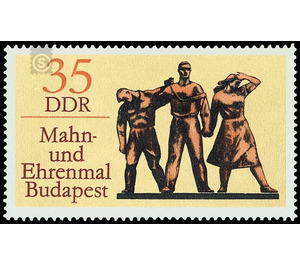Commemorative stamp series - Germany / German Democratic Republic 1976 - 35 Pfennig
Theme: Architecture
| Country | Germany / German Democratic Republic |
| Issue Date | 1976 |
| Face Value | 35.00 |
| Color | brown |
| Perforation | K 14 |
| Printing Type | Rotogravure 2 |
| Stamp Type | Postage stamp |
| Item Type | Stamp |
| Chronological Issue Number | 1911 |
| Chronological Chapter | GER-DDR |
| SID | 407567 |
| In 18 Wishlists | |
Remembrance and Memorial Budapest As part of the series "International Remembrance and Memorial Sites", the Ministry of Posts and Telecommunications of the German Democratic Republic issues a multicolored special postage stamp depicting a detail from the memorial and memorial in Budapest. Remembrance and Memorial for Hungarian Patriots in Budapest In the capital of the People's Republic of Hungary, Budapest, in 1958, this impressive remembrance and memorial was erected, in which the remains of the militants for the cause of the working class, for social progress, and peace Humanism are embedded. Apart from Hungarian patriots and freedom fighters, outstanding representatives of the international workers' movement also found their last resting place here. The impressive memorial site is named "You have dedicated your life to communism and the people". The freedom-loving Hungarian people had to live since 1919 under a reactionary fascist regime. The Horthy dictatorship was still erected in 1919 in the fall of the Hungarian soviet republic. In a hard, difficult and victim-rich struggle, the Hungarian anti-fascist resistance fighters faced two fascist parties. It was the so-called "PfeilkreuzIer" and the organization "Awakening Hungary". Both organizations worked very closely with the Gestapo during Hitler's fascist times. In the struggle for social and national liberation and independence of the Hungarian people fell numerous upright anti-fascist resistance fighters, others were sentenced to death by fascist courts and executed or murdered at the time of arrest. Most of those killed or killed in battle were class-conscious workers and revolutionary leaders of the labor movement. Other patriots, including soldiers who had formed resistance groups within the Horthy army, were also victims of fascist terror. The persecution of the anti-fascist resistance fighters took on extremely brutal forms. Initially, the "suspicious elements" were put into criminal divisions and sent to the frontline's most dangerous battlegrounds. Only a few anti-fascists escaped death in these divisions. They therefore bore the name "mobile gallows". Numerous anti-fascist resistance fighters were deported to concentration camps, from which few returned. In Mauthausen alone 12,923 Hungarian prisoners died. During the persecution 200,000 Hungarian Jews were murdered. To liberate Budapest from the fascist yoke, hard and heavy fighting was fought. It took 45 days for the city to be liberated by the Soviet army and Hungarian anti-fascist resistance fighters. The fallen during these battles are also buried in the memorial and memorial. On special days of remembrance, the Hungarian population, especially the young generation, lays down flowers and wreaths.


